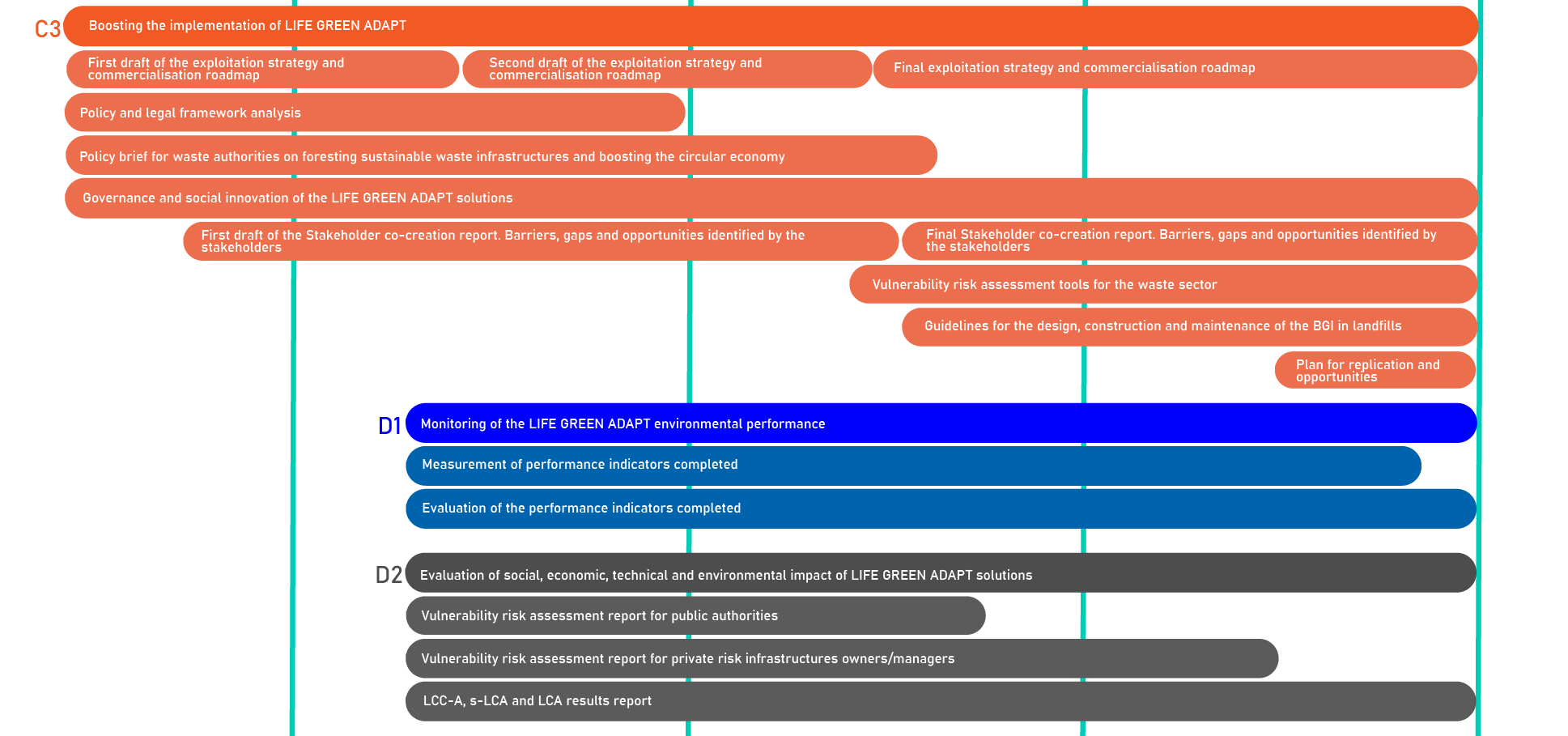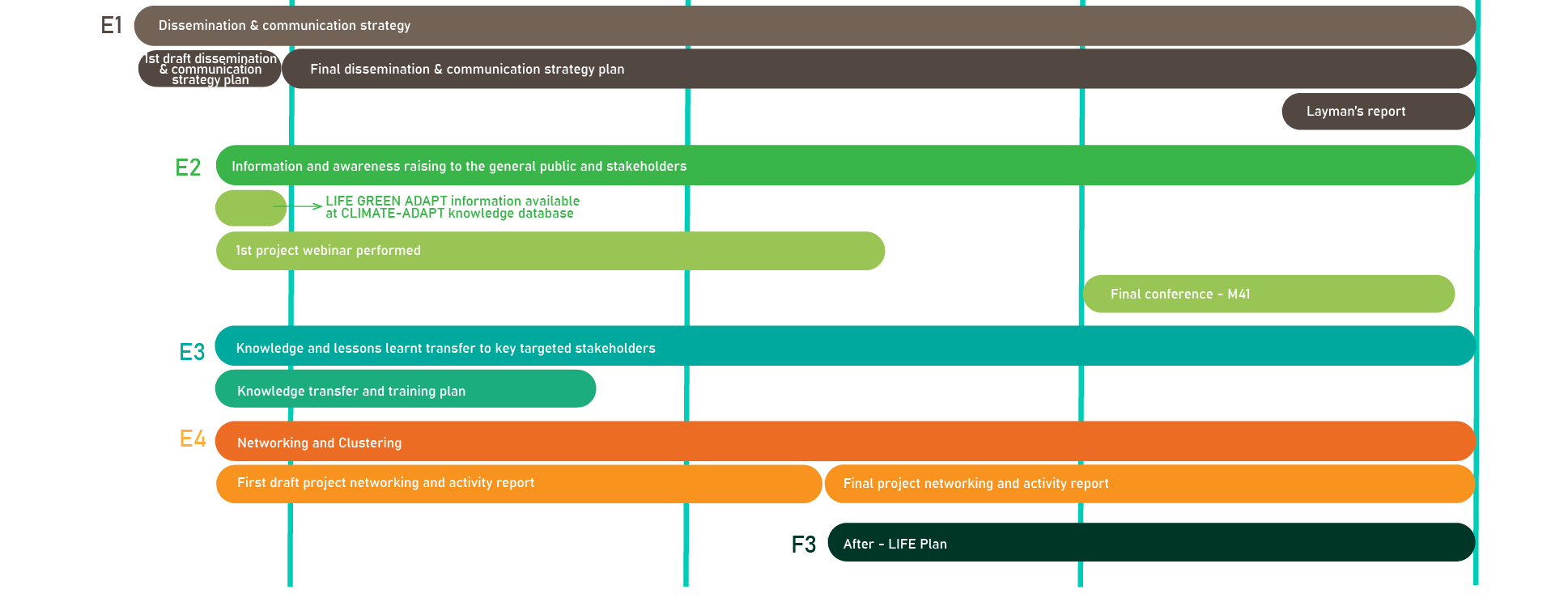Actions
Timeline for LIFE GREEN ADAPT
Brief Description of Main Actions
Click for in-depth description of each main actions.
To define the actual requirements and specifications needed to be met, the common approach among partners about how to tackle the challenge from the technical perspective and to agree the technical configurations for the successful implementation of the project and achievement of its objectives.
A 2 step-process will be performed in order to develop the blueprint and engineering the implementation of the project. Firstly, the design of the BGI LIFE GREEN ADAPT which will apply the principles of eco-design to minimise the environmental burden resulting from the construction of this system. Secondly, once the detailed blueprint (engineering project) is elaborated and design details of each LIFE GREEN ADAPT technology are fixed, the corresponding descriptions and specifications for suppliers will be included in a tender document The tender document will be distributed to the relevant suppliers and proposals will be requested. The various proposals will be evaluated, compared and purchase orders will be issued to the highest added-value bidders accounting economic, technical and environment aspects.
It will consist of carrying out the necessary work to implement the BGI at XILOGA demo site, including:
- demo site preparation,
- bio-technosoils preparation,
- treatment wetlands construction,
- overall working system installation,
- start-up and optimisation of wetlands systems,
- system functioning evaluation.
The operation, validation and optimisation of all technologies will be carried out to achieve a good landfill stabilisation and to get the best performance from a hydraulic and organic load point of view for the treatment wetlands.
Continuously collection and analysis of operation, maintenance results of LIFE GREEN ADAPT systems will help understand how different weather conditions influence the wetlands and bio-technosoils of LIFE GREEN ADAPT systems and their response in adapting the landfill infrastructure to climate change.
A set of synergic actions are planned to ensure the highest results for replication and the widest transfer potential (from exploitation or IPR to the involvement of stakeholders in the co-creation, assessment of barriers and the development of guidelines & tools easing the results uptake and transferability).
Monitoring the environmental performance of the implemented solutions towards the expected project KPIs (emissions, stability, water, etc.). The main purpose of this action is to identify and, more important, quantify the expected positive impact of project actions on the environmental and climate performance.
Application of the latest methodologies on assessing life-cycle approaches from an environment, economic and social perspective and, the use of the vulnerability risk assessment methodology to assess the landfill adaptation against climate change.
Technologies used in LIFE GREEN ADAPT solutions are more cost-effective alternatives than traditional construction solutions (which typically involve higher costs, e.g., slope stabilization techniques, water retention tanks, filters and chemicals for treatment). Cost-benefit analyses considering various scenarios will be performed to ensure that the solutions proposed by the LIFE GREEN ADAPT project remain attractive.
An effective plan (including participation at key events -trade fairs, conferences, events, workshops-, development of materials – website, papers, articles, videos, newsletters, layman’s report-, further identification of targeted audiences…) will reinforce the above mentioned transferability activities during the entire project.
The project will deploy and execute several activities to inform about LIFE GREEN ADAPT activities, raise awareness and engage the general public and key stakeholders.
Beyond the general dissemination activities, LIFE GREEN ADAPT will develop and deliver a training plan (including the definition of target audiences, activities, KPIs, timing and responsibilities) and the exchange of relevant information (guidelines, fiches, tools) and lessons learnt during the project to a key group of targeted potential LIFE GREEN ADAPT solutions adopters, smoothing project replication and transferability of results.
LIFE GREEN ADAPT foster collaboration and knowledge sharing with other relevant LIFE and R&D projects (H2020 and Horizon Europe, mainly), contributing to the uptake and replication of results and smoothing the project objectives achievement. Moreover, it is envisaged the participation in sectorial and key platforms/associations and their associated events. Collaboration with UNESCO Water Division will increase transfer and knowledge exchange to a global dimension.
The After-LIFE Plan will consist of a document gathering project partners commitment on the actions to be continued after the funding period. LIFE GREEN ADAPT as a demonstration project will continue its implementation and boost the market adoption of its results, and will also commit a great effort in the continuation of dissemination and communication actions beyond the end of the project.



